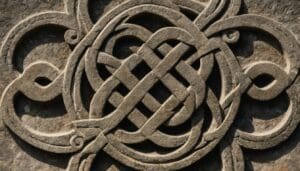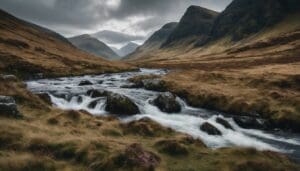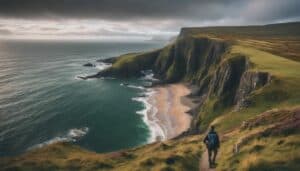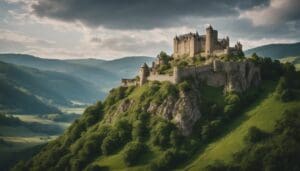Best Things To Do In Lucerne, Switzerland
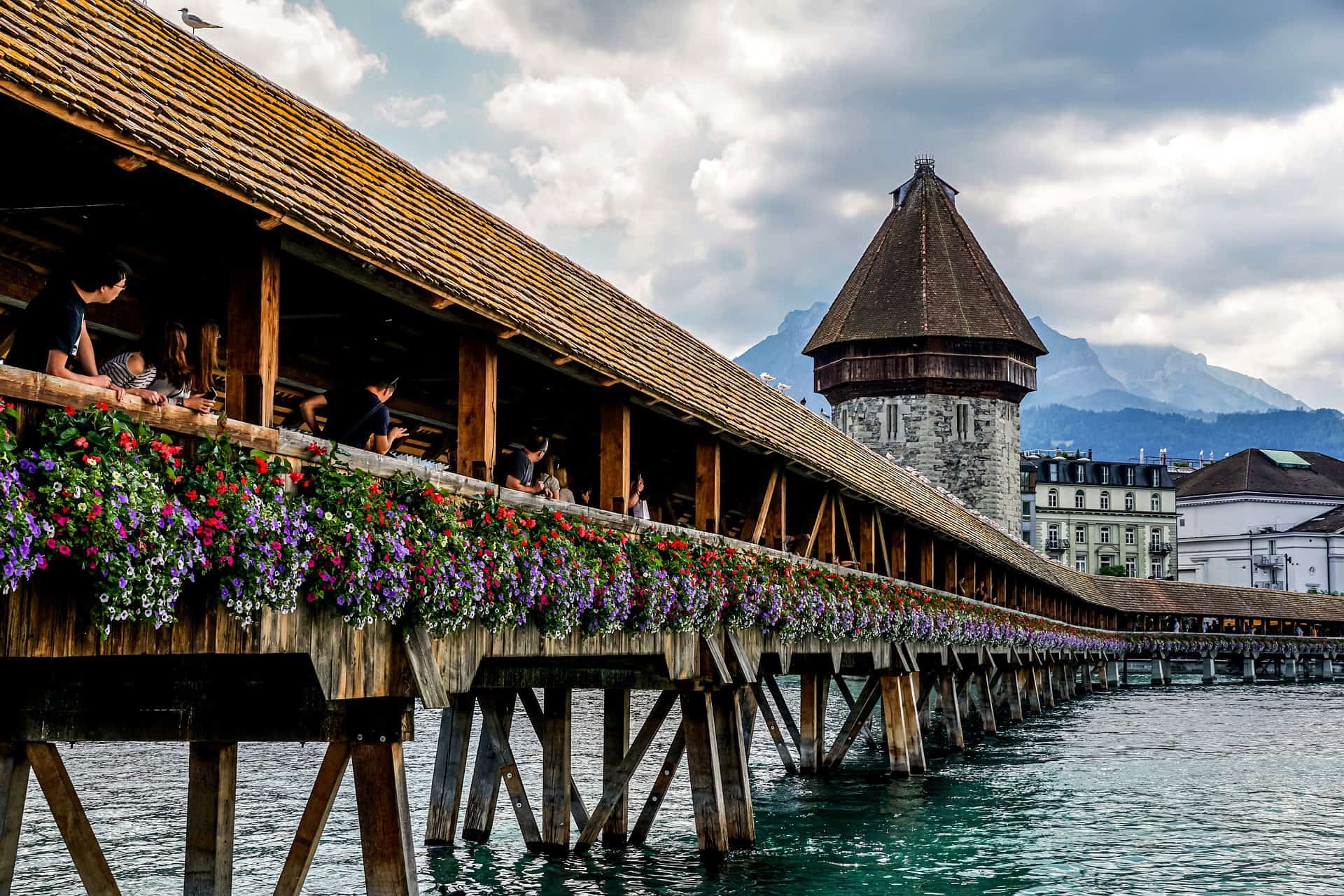
Updated On: November 09, 2023 by Esraa Mahmoud
Lucerne is a real cozy, manageable city that is nestled in the middle of Switzerland’s mountain and water world. Here you’ll find trendy cafes, hipster stores, and well-known brand stores, and you’ll still be in the middle of the alpine mountains within a short time to switch off.
Lucerne, AKA Luzern, is located directly on the water. It is situated on the shores of the Lake of the Four Cantons and is surrounded by mountains. The city is famous among tourists because of its location and its charming old town. Lake + mountains + mesmerizing historical center, what more could you ask for?
Lucerne is simply an excellent starting point to explore various places. Within an hour you can reach famous tourist hotspots like the Rigibahn or the Pilatus. Even if you want to make a day trip to Zurich or Bern, you can reach both cities within an hour by train.
Bringing you the best of what the city has to offer, here is our list of the best things to do in Lucerne and places to visit.
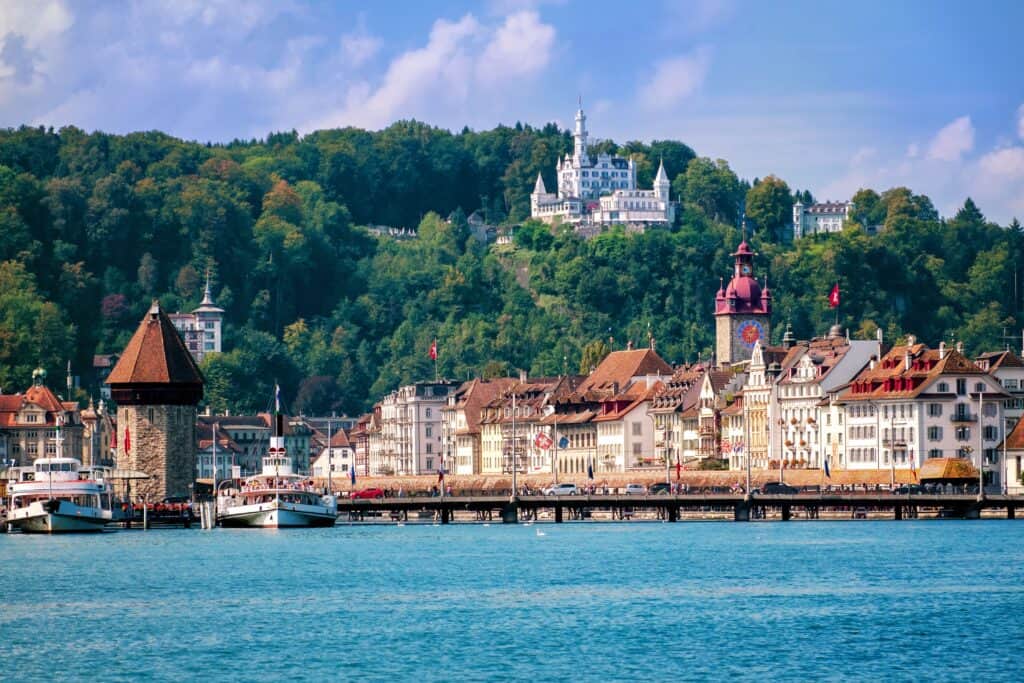
The Old Town
Take as much time as you can to wander along the right bank of the river Reuss and explore the historic center of Lucerne. Here, you’ll find a succession of squares surrounded by colorful medieval houses. The squares are connected to one another by cobblestone market streets.
Traffic is prohibited in the central part of the old town for the convenience of shoppers and all other tourists. An unmissable starting point during a walk around the old town is Weinmarkt Square, which is surrounded by medieval town halls, some of which stand out for their colorful decorative facades.
Another must-see in the area is the Old Town Hall, which was built in the early 17th century in the Italian Renaissance style and has magnificent arcades on the ground floor. A stroll through The Old Town is the perfect start to your trip to Lucerne.
Kornmarkt Square
The Kornmarkt is the site of the medieval market square. It is a small, quiet area of the city with many stores, restaurants, and the charming clock tower Kornschütte. Most of the buildings on this square look incredibly decorative, thanks to the brightly colored facades.
The square is certainly worth a visit. Not only is it beautiful but it’s also close to landmarks like the railway station and the Chapel Bridge.
Swan Square
Schwanenplatz square is located in the old part of the city near Lake Lucerne, where you can often see graceful swans, that’s why it got its name – Swan Square. This is a must-visit for fans of good watches, as the square has a large number of stores where you can buy high-end watches such as Rolex, Patek Philippe, Omega, and others.
There are also many patisseries selling excellent chocolates, as well as a number of lovely establishments that are perfect for a quick bite to eat.
Chapel Bridge
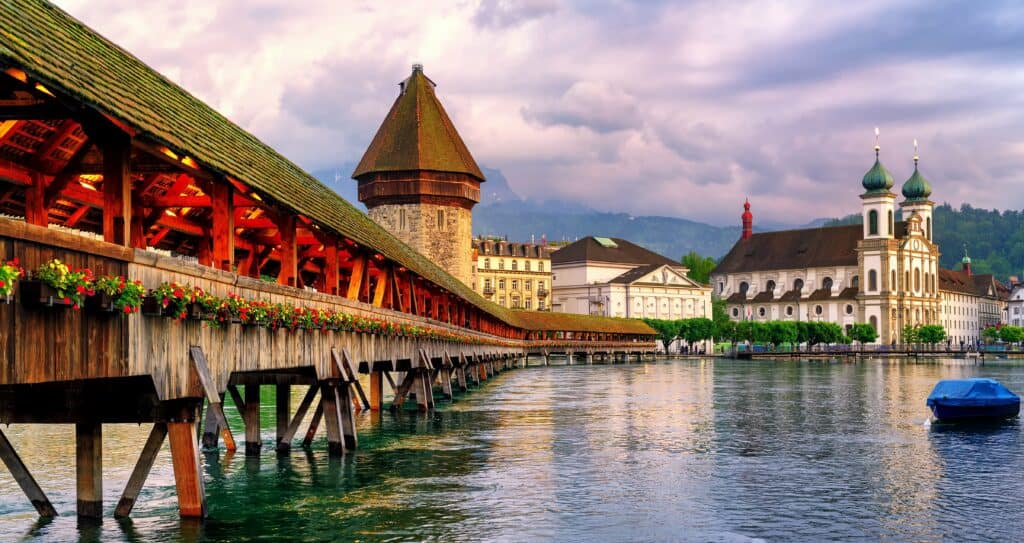
The Chapel Bridge or Kapelbrücke, which crosses the river Reuss, is considered the oldest wooden covered bridge in Europe. It is also among the major attractions of Switzerland and is a symbol of the city of Lucerne.
The Kapelbrücke Bridge, which is over 200 meters long, dates back to the 14th century. The most striking feature of the bridge is the paintings on the roof; there is a total of 111 triangular paintings used to be on the bridge. The pictures depict important events in Switzerland and Lucerne history, as well as scenes from the lives of the town’s patron saints. There are no bridges with similar paintings in any city in Europe.
After a fire in 1993, only 30 remained out of the original 111 paintings. In the middle of the bridge is a 35-meter tower, which was built some 30 years before the bridge. It was originally a watchtower; later, it was used for different purposes – water tower, fire tower, archive, etc. The Chapel Bridge is like no bridge you have ever seen before.
Jesuit Church
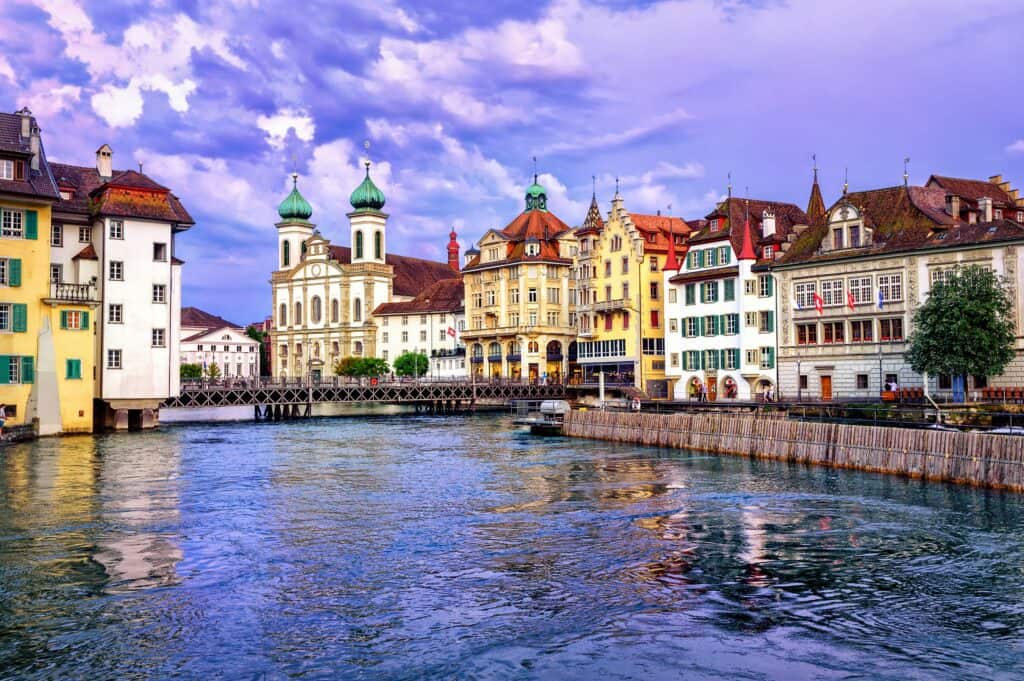
The Jesuit Church is dedicated to St. Francis Xavier. It was the first large baroque church in Switzerland at that time. It became a kind of beacon at the height of the Counter-Reformation for such Protestant cities as Geneva and Zurich.
The construction of the structure continued throughout the 16th and 17th centuries, and the lighting of the temple took place in 1677. The exterior and interior of the Jesuit church are characterized by luxury, typical of the Baroque style. For example, inside the temple, you can see rich stucco in the side chapels, a striking example of the work of the Wessobrunn School of molders (Germany).
The Jesuit church is an imposing church located on the river. It is pretty from the outside but really reveals its richness when you pass its door: it is a masterpiece of baroque art! It is one of the best places to visit in Lucerne.
Church of St. Leodegar
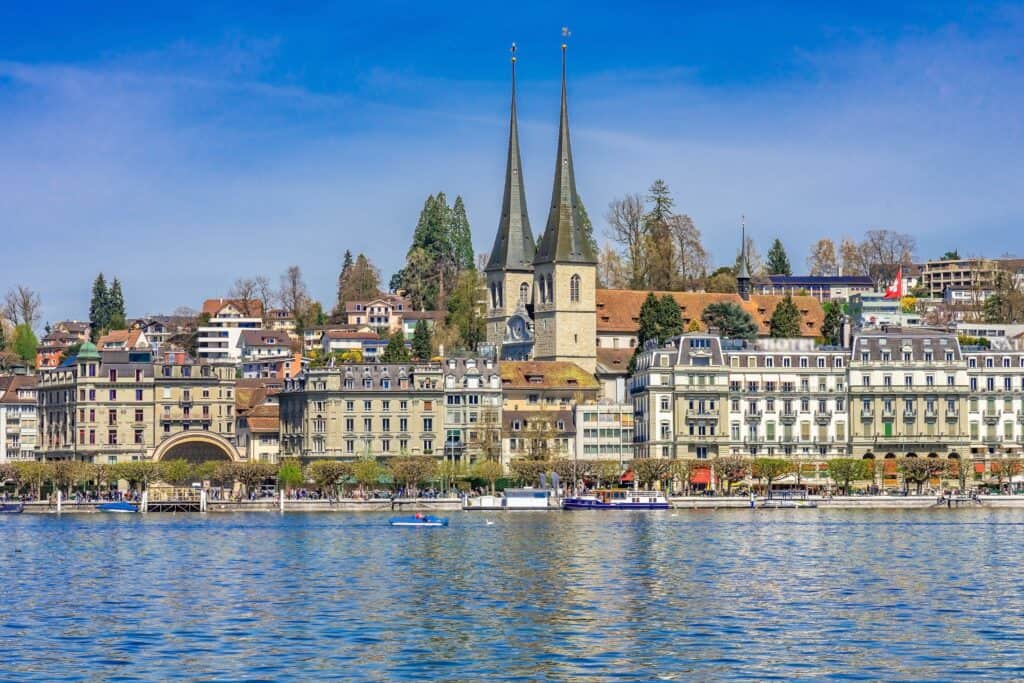
The medieval Romanesque Basilica that stood in the 17th century on the site of the present church burned to the ground in a great fire. In the 1630s, when the Thirty Years’ War was still raging, the town decided to build a new church, one of the few built at that time at the north of the Alps.
The church belongs to the canonical monastery of St. Leodegar and is a Romanesque building. In former times,0 the church belonged to a Benedictine monastery.
In the north aisle, you will find a colorful Gothic relief depicting the Assumption of the Blessed Virgin Mary, dating back to 1500 – it was miraculously saved in a fire. Other interior elements, added in the 17th after the reconstruction of the old building, are also worth attention: the high black marble high altar and the wooden choir with filigree carving. The Church of St. Leodegar is one of the most beautiful churches you will ever see.
Mount Pilatus
Mount Pilatus is closely connected with local folklore. According to a medieval legend, dragons with healing powers lived on its summit, so in those days, Pilatus was called the Dragon’s Mountain. One of the best things to do while there is hiking to the top; it is an unforgettable adventure.
In the summer season, there is a special route, Goldene Rundfahrt, during which tourists go from Lucerne on a paddle steamer. Once ashore, you will have the chance to take the world’s steepest railroad, with a maximum gradient of 48º and a unique gearbox.
After admiring the mountain scenery, you can take the new Dragon Ride cable car and go down. Visiting Mount Pilatus is one of the best things to do in Lucerne.
Mount Rigi
Mount Rigi is a mountain range in Central Switzerland, which is clearly visible from the city of Lucerne. This is a unique place, surrounded on three sides by lakes – Lucerne, Zug, and Lauerz. You can climb the mountain by cable car or by cogged railroad, and from the top, you will enjoy a stunning panoramic view.
There are regular shuttle buses to Mt. Riga; however, you can get to the cable car or if you are looking for a more exciting way, you can take a steamboat cruise that departs from the Lucerne city wharf. While visiting the mountain range, photographers will have a chance to take some incredibly picturesque and captivating shots! As for hikers, there is a fascinating and unforgettable ascent to the summit waiting for them!
Lake Lucerne
Lake Lucerne, AKA Lake of the Four Cantons, is a body of water of great beauty. The lake is surrounded by mountains on all sides and consists of four basins that are connected by narrow straits. In the 1880s, the coastal areas of Lucerne were redeveloped to make the most of the beauty of the local landscape.
To admire Lake Lucerne, you have to get to the city harbor Luzern Bahnhofquai and board one of the five paddle steamers of the early 20th century, which regularly take sightseeing cruises. It is not to be missed!
National Transport Museum
The Verkehrshaus der Schweiz (National Transport Museum) is one of the most visited museums in Switzerland. It is located on the shores of Lake Lucerne and has a rich collection of all kinds of vehicles, including cars, planes, trains, fire engines, and other special vehicles.
There are more than 3,000 exhibits on the museum’s 20,000 m² area. Among them, there are special machines, such as the first diesel locomotive in Switzerland, 30 airplanes, and even an Automobile Theater; a garage where models of cars from different epochs are placed on the shelves like toy cars in rows in six tiers.
Apart from the different kinds of vehicles, there are other attractions such as a renovated planetarium, Switzerland’s first IMAX cinema, and a 200 m² large aerial view of Switzerland from space – a map of the country. A visit to the National Transport Museum is a must while in the city.
Lucerne railway station
If you like trains and haven’t admired them enough at the Swiss Transport Museum, head to the Lucerne railway station. The substantial two-story building with interesting architecture is located in the central part of Lucerne near the lake. It has a huge waiting room, ticket offices, luggage lockers, and other passenger services, but there are also many stores, cafes, and snack bars in the train station, where you can get a quick and delicious meal.
The Town Park of Inseli
Just a stone’s throw from the train station, on the shores of Lake Lucerne, there’s a lovely green park, The Town Park of Inseli, where locals like to come in sunny weather to relax on the lawn, play ping pong outdoors or sit at tables in the Volière and Buvette summer bars. Make sure to pay the park a visit while in the city.
The Dying Lion Monument
The dying Lion of Lucerne is one of the most famous monuments in the world. If you love sculptures, you will like the Lion Monument. It is over 200 years old and shows a lion dying because of a spear in its back. It is meant to commemorate the fallen Swiss guardsmen during the French Revolution.
The sculptural composition, based on a sketch by the Danish sculptor Bertel Thorvaldsen, was executed by another sculptor, Swiss Lucas Achorn. The work was completed in the early 1820s. The parted lion is the personification of the brave Swiss Guard who fell on August 10, 1792, while defending the Tuileries Palace, where Louis XVI was staying.
Under the dying lion is inscribed Helvetiorum Fidei ac Virtuti, which means to the loyalty and bravery of the Swiss. This sculpture is very famous, and you will see a lot of tourists around it, but it is worth going to see it. The statue is a 5-minute walk from the city center, and it is awe-inspiring!
Glacier Garden
Next to the Lion Monument is a natural site whose discovery in 1872 shocked the entire scientific world. This geological phenomenon is a bizarre ancient rock formation with potholes, caverns, and caves, which were formed 20,000 years ago during the Ice Age. The ice caves contain even more ancient formations – fossils of palm leaves and shellfish, showing that about 20 million years ago, this place was a subtropical sea.
In addition to unique natural formations, in the Glacier Garden, you can visit the hall of models with landscapes of Switzerland. The invariable interest of visitors causes the mirror maze Alhambra – an attraction of 90 mirrors, which opened in 1896.
Climbing up to the observation deck, you can admire the breathtaking panorama of Lucerne against the backdrop of the Pilatus Massif. Make sure to add visiting the Glacier Garden to your program.
Bourbaki Panorama Museum
Not far from the Lion Monument and the Glacier Garden is another attraction in the city, the Bourbaki Panorama Museum. The museum has a huge circular painting about the internment of the French army in Switzerland after its defeat against Germany in 1871.
The French army was then cornered by the German army in the Jura and had only one solution: to ask Switzerland for the right to take refuge on its territory. In the early 1870s, Swiss artist Edouard Kastr painted a grandiose canvas measuring 112 by 10 meters. It is one of the few large-scale panoramas of the 19th century that have survived to this day.
In the painting, against the backdrop of snowy landscapes, exhausted soldiers are crossing the border, retreating into neutral Switzerland. In the pavilion, where the panorama is located, you will find a small museum is open, which tells a lot of interesting things about the events of the Franco-Prussian War and the history of the creation of the unique artistic canvas.
Historical Museum of Lucerne
If you want to learn more about the traditions and culture of this region of Switzerland, visit the Lucerne Historical Museum. It is located near the Jesuit Church and the Sproeuerbrücke Bridge. Although the museum is small, it has several captivating displays that include medieval artifacts from the 15th century, such as a Gothic fountain and Italian infantrymen’s shields.
The Jungfraujoch Pass (Jungfraujoch)
The Jungfraujoch Pass is about 80 kilometers from Lucerne. It is known as the summit of Europe and is listed as a World Heritage Site. It is also the highest railway station on the continent at 3,454 meters. On the elevator, you can go even higher – to the top of the Sphinx height of 3,573 m. There you can visit the Ice Palace and enjoy the breathtaking views of the mountainsides from the Sphinx observation deck.
Engelberg Village and Mount Titlis
The small village of Engelberg in the mountain valley is a popular winter and summer destination in Central Switzerland. It is one of the top 10 Swiss ski resorts, attracting skiers and snowboarders from all over the world.
In the summertime hikers, mountain climbers, mountain bikers, and golfers come here. At any time of the year from the chairlift Ice Flyer offer breathtaking views of the Bernese Alps. For lovers of old times, it is worth visiting the active Benedictine monastery in Engelberg, which dates back to the 12th century and is still dominated by monks.
Culture and Congress Center (KKL)
The Culture and Congress Center (KKL) is a stunning work of modern architecture and the youngest of all Lucerne’s landmarks. The Culture and Congress Center (KKL) is located on the shore of Lake Lucerne, where the river Rois flows out. The high-tech building was designed by the famous French architect Jean Nouvel, and the center itself took shape between 1995 and 2000.
The main feature of the building is its vast flat roof overhanging the waterfront. Beneath the enormous roof is a complex consisting of three separate buildings. Of all the rooms, the most famous is the concert hall for 1,800 seats, which surpasses many world venues in quality of acoustics. The building also houses a part of the Lucerne Art Museum with works by artists and sculptors from different periods, from the Renaissance to the present day.
The Musegg Wall
The Muzgg fortress wall is a remnant of the fortifications erected at the end of the 14th century to protect the city from the north. Along the 900-meter-long wall of Musegg, there are nine tall watchtowers. Four towers are open to the public, including the famous Zitturm Tower, where you can see the oldest clock in the city.
It was made in 1535 by Hans Luther, and the citizens gave it the unique privilege of striking the hour one minute before every other clock in the city. The other three towers are also worth a visit for a view of the city and the beautiful lake.
Rosengart Collection
The successful art dealer Siegfried Rosengart in the first decades of the twentieth century was in close contact with the famous artists of that time. Together with his daughter Angela, he amassed one of the wealthiest contemporary art collections in Europe, including many works by renowned artists such as Chagall, Monet, Matisse, Miró, Braque, and Fernand Léger.
But the real jewels of the collection are the priceless works of Pablo Picasso and Paul Klee – they have a special place in the Sammlung Rosengart museum, located in the former building of the Swiss National Bank. The museum was opened in 2002 at the initiative of Angela Rosengart, who inherited the rich collection of her father. Today the museum counts more than 300 paintings in its exposition. It would be a waste to go to Lucerne without visiting the museum.
Richard Wagner Museum
This museum is located in the former estate of Richard Wagner. The world-famous composer lived here with his family for six years, from 1866 to 1872. It was here that Wagner began his musical drama Götterdämmerung (Death of the Gods), wrote his opera Die Meistersinger von Nürnberg (The Meistersinger von Nürnberg) and a number of other famous works.
The museum’s exhibitions are dedicated to Wagner and the years of his life in Lucerne. Here, you will see rare archive records, original scores, canvases, historic photos, and antique furniture. The unique collection of ancient musical instruments deserves special attention, and its pearl is undoubtedly the portable organ by Sebastian Érard, on which the composer composed his masterpieces.
It’s no wonder why Lucerne is so beloved by tourists. The city is located next to the picturesque Lake Lucerne, surrounded by breathtaking mountain scenery. Also, its natural attractions are not far from the city, so it’s easy to get to them, whether you’re planning to admire the lake on a steamboat cruise or conquer the mighty alpine peaks. There’s plenty to see and do in the city!


